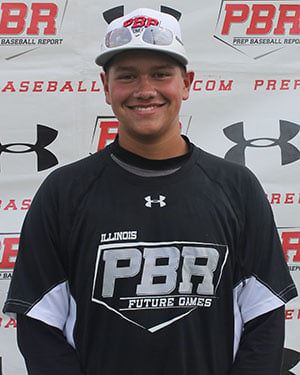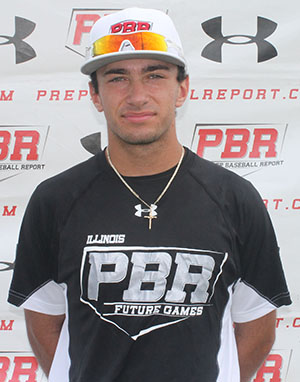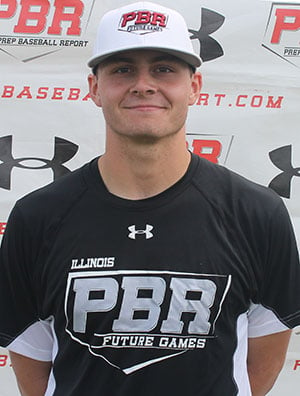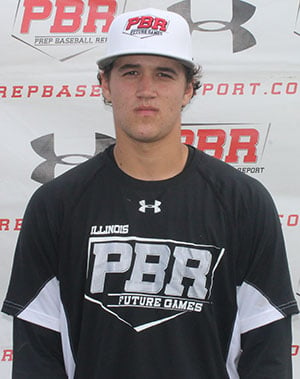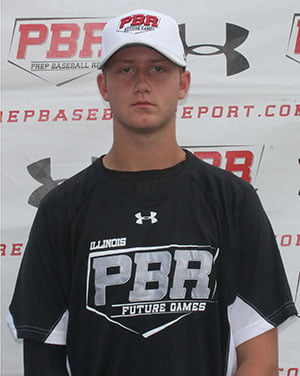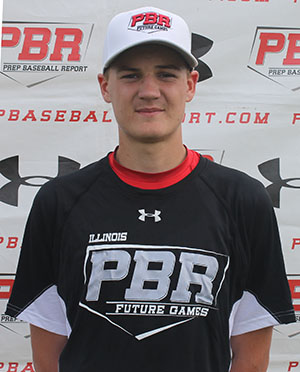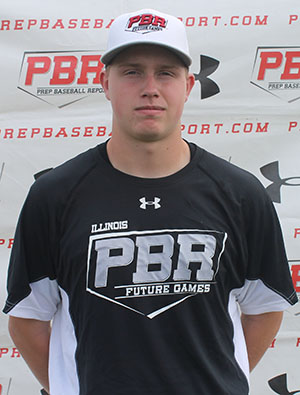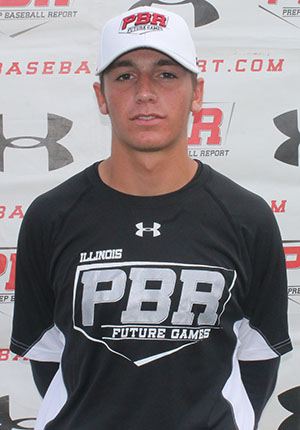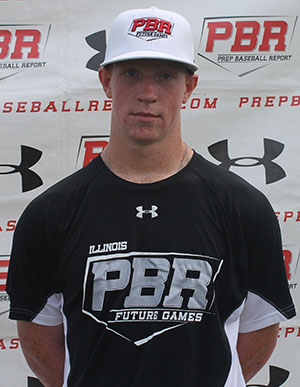Future Games: Team Illinois Pitching Staff Highlights
August 5, 2014
By Ryan Quigley
Illinois Scouting Director
The Prep Baseball Report Future Games took place this weekend at Grand Park in Westfield, Indiana outside of Indianapolis. The Future Games is comprised of ten teams from different states in the PBR coverage area. Day one featured a showcase format for the positional players, while days two and three gave each team the opportunity to play three games. Team Illinois finished 1-1-1, winning their first game over Team Missouri 4-3 on day one. In game one, the Illinois pitching staff combined to allow only three hits. On day two, Illinois dropped a game 6-2 to a talented Team Ohio, and tied 1-1 in the final contest of the Future Games against Team Indiana. Due to each pitcher being limited to one inning, the contest was unable to continue into extra innings. Several Illinois players made their mark on the over 100 college coaches in attendance, none more that Jacobs HS's Brenden Heiss. Heiss showcased the top fastball velocity at the Future Games, sitting 90-92 mph, without dipping below 90 in either of his two outings. He also reportedly touched 95 mph on the stadium radar gun in his second outing. Today we will highlight pitchers from Team Illinois.
Here’s a look at some of the pitching highlights from Team Illinois, in no particular order:
Team Illinois Pitching Highlights
+ Garret Acton, RHP, Lemont, 2016
Acton impressed in his two innings in game two against Team Ohio, recording a strikeout and giving up one run. His fastball sat 87-88 mph from a short, quick, over the top arm action. He does a great job of loading his lower half over the rubber, and pounds the zone with three pitches. His 75-77 mph slider flashes above average potential at times, and his 77-79 mph changeup has sinking action. Acton currently carries some baby fat, and his youthful appearance bodes well for future velocity projection as he continues to focus on his athleticism. He impresses with his ability to go right after hitters with his fastball. His second frame was a quick one-two-three inning. Acton is already receiving national recruiting attention, and should step into Jake Latz’s shoes as Lemont’s ace over the next two years.
+ Brandon Bossard, SS/RHP, Nazareth, 2016
Bossard impresses both on the mound and in the infield, though his bat and fielding prowess are most likely ahead of his pitching abilities currently. He went 3-for-8 at the plate over three games, with an RBI- ground rule double to right center field in game three vs. Team Indiana. Bossard was quite possibly the MVP for Team Illinois in game three, as he preserved the tie on the mound, stranding a runner at third base with a fly out to center and a looking strikeout on a 12/6 curveball to end the game. Bossard worked at 83-85 on the mound, with a 67-69 mph curveball with true 12/6 shape. He competes, and could throw harder down the road if he lengthened out his stride, which currently is extremely short, but keeps him on top of his plus curveball.
+ Ben Brecht, LHP, New Trier, 2016
The 6-foot-7, 200 pound lefty impressed with his projectable frame and 83-86 mph fastball. He allowed two runs in his two innings of work against Team Ohio, but struck out three. His 66-68 mph curveball shows 11-5 shape, and he threw it for strikes in the bullpen, but he needs to focus on not slowing down his arm and adding velocity to the pitch. His changeup looked like a better secondary offering warming up in the bullpen, but he did not use it in the game. Brecht’s arm action is long, and clean, and he’s garnering significant national recruiting attention, as 6-foot-7 left-handers are a rarity.
+ Cal Coughlin, 3B/RHP, Carmel, 2016
Coughlin put on a show during batting practice on day one, showing legitimate switch-hitting ability, and leaving the park from both sides of the plate. He possess a physically advance, plus frame at 6-foot-1, 200-pound, and impressed in all three games at third base with his soft hands and arm strength at 86 mph across the diamond. He was susceptible to strikeouts during game action, but also barreled two singles, and played errorless baseball at third, with several put outs. On the mound, Coughlin worked from 83-86 mph touching 87with a hard 76-77 mph slider/cutter. He walked three and struck out two. Coughlin is a legitimate two-way threat and the next level, and no doubt focusing on one or the other would improve either his hitting or pitching, but the overall package his hard not to like and it’s a decision he’ll likely not have to make until college/professional baseball.
+ Brenden Heiss, RHP, Jacobs, 2016
Heiss started Game 1 and showed electric stuff on back-to-back days, consistently pounding the zone with his 90-92 mph heater. In two innings pitched over the two days, Heiss allowed only one hit, and was extremely efficient, producing weak contact with several ground ball outs. His 73-74 mph palm ball behaves like a curveball at times, and if he finds a harder breaking ball over the next few years, he could become a high draft pick. He shows great arm speed in the bullpen on his 79-81 mph two-seam changeup, but did not have to use it often in games. Heiss hit 95 mph on the stadium gun that was setup on day two, but another gun next to it read 92. He did not throw a fastball under 90 mph in his two appearances. Regardless, the 6-foot-1, 200-pound righty has electric stuff and is garnering national recruiting attention.
+ Ryan Kutt, RHP, Brother Rice, 2017
Kutt is a 6-foot-1, 168-pound right-handed pitcher who was one of the top 2017 arms in attendance at the 2014 Future Games. He has advanced pitchability for a sophomore in high school, with a feel for three pitches, especially his hard, late-breaking slider. Kutt’s fastball sat 85-87 mph on day one, which was a quick outing with three ground ball outs. On day two against Team Indiana Kutt struck out the first two hitters looking with his 77 mph slider. His fastball sat 84-85 with sink, and he also shows a feel for a 74-75 mph change. He allowed a ground ball single up the middle, that Jeremy Houston nearly turned into a highlight reel play, and Cooper Johnson cut down that runner at second to end Kutt’s outing and give him two clean, scoreless innings over the two days of games. He shows the maturity of an older player both on the field and in the dugout, and should be one of the top arms in the competitive Chicago Catholic League over the next three years.
+ Brad Littleton, RHP, Coal City, 2016
The 6-foot-2, 180-pound righty impressed on both days with his 88-90 mph fastball, and hard 71-74 mph breaking ball. In game one, Littleton was greeted with single and triple from the first two batters he faced, but quickly settled down stranding a runner at third by striking out the side. On day two, with the starting nod against Team Indiana, he worked more in the 87-88 mph range, recording a 1-2-3 inning with two groundouts and a swinging strikeout on a 74 mph curveball up in the zone. He showed a good feel in the bullpen for a 75-76 mph sinking changeup, but slightly slows his arm at times. His projectable, lanky frame, and current fastball velocity make him a highly attractive recruit in the class of 2016.
+ Brady Huffman, RHP, Genoa Kingston, 2016
Huffman is a 6-foot-2, 160-pound lanky right-handed pitcher with extremely long levers. His hands are large as well, and with his skinny frame he projects to throw harder down the road as he naturally adds weight. Huffman worked at 86-88 mph with his fastball on day one and recorded a quick one-two-three inning. On day two he worked more in the 84-86 mph range, but still touched 87-88 a few times. He also throws a 72-73 mph curveball with depth. Mechanically, Huffman’s arm action is short and clean, but he does open up towards the first base side with his lower half early. He’s a high follow arm, who could see draft interest in two years if his velocity spikes like his arm action and frame suggests.
+ Cole Miller, LHP, York, 2016
Miller is a 6-foot-4, 200-pound left-hander with huge feet and a frame he is still growing into. He looks young, and has impressed over the summer with a fastball that touches 85 mph. At the Future Games Miller’s fastball sat more in the 80-82 mph range, but he impressed with his ability to make adjustments from day one to day two. It’s been documented in the past that his heel moves forward on his drive leg, causing him to throw across his body, and limit his ability to repeat his delivery. Miller struck out the side on day one, creating a tough angle for left-handed hitters with his fastball, and sweeping slurve at 68-71 mph. On day two, he showcased the same stuff, and again had a one-two-three inning, but not in the traditional fashion. His first hitter reached on an infield error, and Miller promptly showcased a nasty pickoff move for out number one. After a dropped third strike on a swinging 70 mph slurve, Miller induced the next hitter into 1-6-3 double play groundout. Added strength should see Miller pitching in the mid 80’s next spring, and possibly higher over the next two years.
+ Joe Santoro, RHP/LHP/OF, Carmel, 2016
While Santoro is a legitimate recruit as an outfielder, he created a buzz among college coaches in attendance when he broke out his switch-pitching routine on day three against Team Ohio. Despite allowing two runs, he showed identical pitching prowess from both sides, sitting 83-85 mph right handed, touching 86, and sitting 84-86 mph from the left side as well. He invoked comparisons to former Creighton University All-American, and current New York Yankee farmhand Pat Venditte, who has found success as a late-inning bullpen weapon. Santoro racked up a strikeout from the left side with a sharp breaking 67 mph slider, and if he can improve his breaking balls from both sides, he becomes a valuable recruit for Division-I programs, as he is essentially three players in one. At the plate, the left-handed hitting Santoro impressed in batting practice hitting from a wide setup spraying line drives, particularly to the opposite field gap. During games, he ran 4.29-4.44 on several ground outs. He shows a contact orientated approach, and did not strikeout over three games. He added an RBI on a HBP in game one, and also walked in game two.
+ Joe Dittmar, RHP, Richmond Burton, 2016
Dittmar is also an accomplished third baseman, but only pitched at this event due to a nagging hip injury. He has shown 91 mph arm strength across the diamond at first base, but sat more in the 84-87 mph range touching 88 several times on both days. He also threw a 72-73 mph curveball. Dittmar gave up a run in each of his outings, but his arm strength and 6-foot-1, 185-pound physical presence on the hill is hard to ignore. He throws across his body, and lands extremely closed at foot strike, which may limit his ability to get his hips through, limiting his extension out front, thus “pitching around a corner”. If Dittmar can clean up his direction and landing, he may showcase that same 91 mph are on the mound as well, as the arm strength is there.
Related Future Games Content
- PBRPlus PBR Future Games: Benninghoff, Saalfrank Stand Out 8.03.14
- PBRPlus PBR Future Games: Team Select Does It All8.02.14
- PBRPlus PBR Future Games: Standouts From Day 28.02.14
- PBRPlus 10 Highlights from the PBR Future Games Positional Showcase7.31.14
- PBRPlus 2014 PBR Future Games Stats7.31.14


